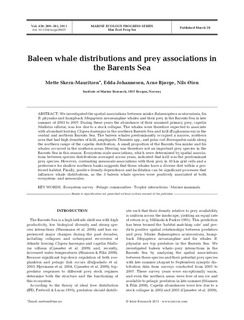| dc.description.abstract | We investigated the spatial associations between minke Balaenoptera acutorostrata, fin B. physalus and humpback Megaptera novaeangliae whales and their prey in the Barents Sea in late summer of 2003 to 2007. During these years the abundance of their assumed primary prey, capelin Mallotus villotus, was low due to a stock collapse. The whales were therefore expected to associate with abundant herring Clupea harengus in the southern Barents Sea and krill (Euphausiacea) in the central and northern Barents Sea. The baleen whales predominantly occupied a narrow, northern area that had high densities of krill, amphipods Themisto spp., and polar cod Boreogadus saida along the northern range of the capelin distribution. A small proportion of the Barents Sea minke and fin whales occurred in the southern areas. Herring was therefore not an important prey species in the Barents Sea in this season. Ecosystem-scale associations, which were determined by spatial associations between species distributions averaged across years, indicated that krill was the predominant prey species. However, contrasting mesoscale associations with their prey in 50 km grid cells and a preference for shallow northern banks suggests that these whales have a diverse diet within a preferred habitat. Finally, positive density dependence and facilitation can be significant processes that influence whale distributions, as the 3 baleen whale species were positively associated at both ecosystem- and mesoscales. | no_NO |
